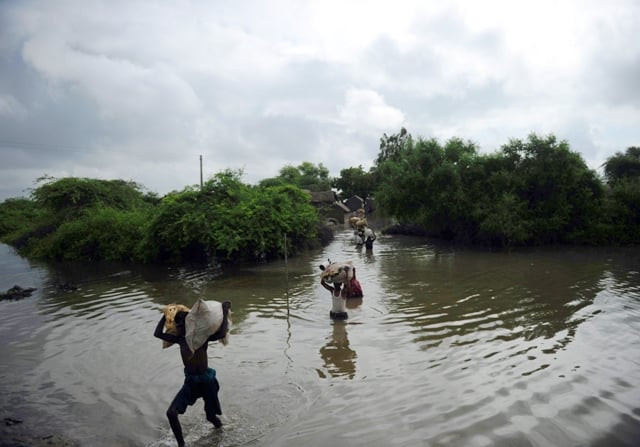Three-year period: Monsoon floods in Pakistan claimed 1,029 lives
About 1,297 people were injured and 4.5m affected since 2014

PHOTO: AFP
Minister for Law and Justice and Climate Change Zahid Hamid shared the details with the Senate session on Thursday in response to a question asked by Muttahida Qaumi Movement’s Tahir Mashhadi.
Around 1,297 people have been injured and 4.5 million affected in the flash floods in 2014, 2015 and 2016.
The highest number of deaths was recorded during 2014 when 367 people were killed and about 232 injured besides about 107,102 houses damaged and 4,065 villages affected.
The details shared the damages caused including deaths, injuries, homes, shops, villages, cattle and total population, and the measures taken by the government.
As per data, the monsoon impacted the lives of 2.53 million people in four provinces, including Azad Jammu and Kashmir (AJK) and Gilgit-Baltistan (G-B). The local disaster management authorities evacuated about 683,930 people and about 518,715 patients were treated.
NDMA prepares framework for vulnerable, low-income communities
During 2014 the death ratio was highest in Punjab with 286 casualties and 512 injuries. About 100,000 houses were also damaged in the province. AJK was the second in terms of damages as lives of 56 civilians were lost with 111 injured followed by 13 deaths in G-B and 12 in Khyber Pakhtunkhwa (K-P).
In 2015 deaths of about 238 people were recorded with 232 people injured and about 1.5 million affected with higher damages in K-P - 109 deaths and 148 injured.
About 11,390 houses were damaged and 4,113 villages affected with 17 deaths in AJK; 15 in Federally Administered Tribal Areas (Fata) and 12 in Balochistan.
Similarly, during the pre-monsoon rains of 2016 about 271 people were killed and 279 injured and this time again 157 deaths in the K-P, 38 in Fata. About 2,929 houses were damaged of which 1,927 were partially damaged and 1,002 completely destroyed.
Meanwhile, during the monsoon of 2016 about 153 deaths were reported and 113 injuries while about 1,456 houses were damaged. Again the K-P had the highest death toll of 69 followed by 29, 27 and 18 in Punjab, Fata and Balochistan, respectively.
Measures
About the measures taken to prevent such casualties, the report said the National Disaster Management Authority (NDMA) was proactively working to reduce risks and vulnerabilities to disasters and provide coping mechanisms/framework to climate change phenomenon.
The NDMA formulated National Disaster Risk Reduction Policy in 2013, providing an overall guiding framework for building resilience of the country to disasters. It aims at strengthening disaster preparedness and response capabilities, improving Early Warning System, building capacities of disaster management practitioners at all levels, communities and strengthening structural and non-structural resilience of infrastructure, it said.
The report suggests that now monsoon preparations start in January every year.
Better preparedness key to saving lives
Besides, the government, with assistance of NDMA, conducts high-level regional consultative meetings, joint reconnaissance of flood protection structures by army, irrigation departments and officials of provincial governments for rectification of observations.
National Monsoon Contingency Response Directive is issued every year in June. This directive is based on Pakistan Metrological Department’s forecast of monsoon season, provincial/regional input to face challenges of approaching monsoon and comprehensive preparedness, prevention, mitigation, rescue and relief plan.



















COMMENTS
Comments are moderated and generally will be posted if they are on-topic and not abusive.
For more information, please see our Comments FAQ